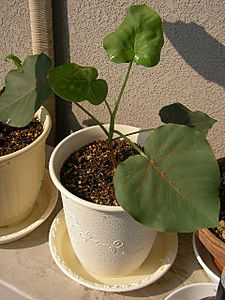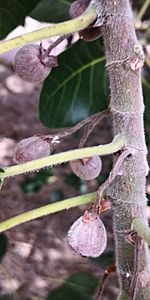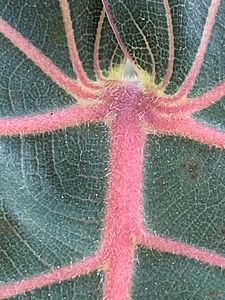Petiolate fig facts for kids
Quick facts for kids Petiolate fig |
|
|---|---|
 |
|
| Scientific classification | |
| Synonyms | |
|
Ficus petiolaris, often called the petiolate fig or rock fig, is a type of fig tree. It grows naturally only in Mexico, from the areas of Baja California and Sonora all the way south to Oaxaca. This tree usually reaches a height of 10 to 20 feet (about 3 to 6 meters). It grows best with a moderate amount of water and some shade. A cool thing about this plant is the tiny white hairs you can see where the leaf veins meet. Other common names for it include the Baja California rock fig, Palmer wild fig, and Brandegee wild fig.
Contents
What Does the Petiolate Fig Look Like?
These trees can grow quite tall, up to 30 meters (about 98 feet) in the wild. If they are grown in a pot as a houseplant, they usually stay smaller, around 8 to 10 meters (26 to 33 feet) tall. The trunk of the tree has a yellowish-green color.
The leaves are shaped like a heart. On the top side, they are a bright green color. On the underside, they have small clumps of whitish hairs. The flowers and fruits are green and round. They also have red, velvety spots on them. The top part of the tree, called the crown, is nicely rounded.
Naming and Classification
How the Petiolate Fig Got Its Name
A German botanist named Carl Sigismund Kunth was the first to describe this plant in 1817. This means he officially named and recorded it for science.
Meaning of the Names
- Ficus: This is the general name for all fig trees. It comes from the old Latin word for fig.
- Petiolaris: This part of the name is Latin and means "with a petiole." A petiole is the small stalk that connects a leaf to the stem of a plant.
Other Names for the Petiolate Fig
- English: Petiolate fig, rock fig, Baja California rock fig, Palmer wild fig, Brandegee wild fig
- Spanish: Higuera, amate, zalate, higuera cimarrona, higuera silvestre
Where the Petiolate Fig Grows
This fig tree is originally from Mexico. It can be found in places with warm, semi-warm, and mild climates. It usually grows at elevations between 550 and 1200 meters (about 1,800 to 3,900 feet) above sea level.
You can find this wild plant in different types of forests. These include tropical forests that lose their leaves, thorny forests, and even oak and pine forests. In the Baja California Peninsula, this plant grows from the southern Sierra de la Asamblea all the way down to the Cape region of Baja California Sur. It also grows on many islands nearby in the Gulf of California.
Traditional Uses of the Petiolate Fig
The bark of the Ficus petiolaris tree was very important to the Aztec people a long time ago. They used it to make a special kind of paper called amate. Many of the old Aztec codices (ancient books or manuscripts) were written on this amate paper.
In the 16th century, a person named Francisco Hernández de Toledo wrote about how people used this plant. He said that boiling the roots and bark could help people with fevers. It was also thought to help with chest pains and to clean out the body. People also used it to help heal old sores on the lips or other parts of the body. In the 20th century, another expert, Maximino Martinez, noted that it was used to tighten tissues, help heal broken bones, cracks in gums, skin rashes, and chest problems.
In Mexico today, some people still use this plant for traditional remedies. It is suggested for issues like tummy problems, skin rashes, coughs, and kidney stones. It is also used to help with women's health and to heal broken bones.
In the state of Sonora, people use it for things like swelling in the neck, chest pains, coughs, and wounds. In Morelos, it is used to help lower fevers. For these uses, people might use the plant's milky sap, juice, or sticky liquid.
In Michoacán, for liver problems, the crushed bark is soaked in water for a day. This water is then used for baths, and some people also drink it for nine days on an empty stomach.
Gallery
See also
 In Spanish: Ficus petiolaris para niños
In Spanish: Ficus petiolaris para niños





